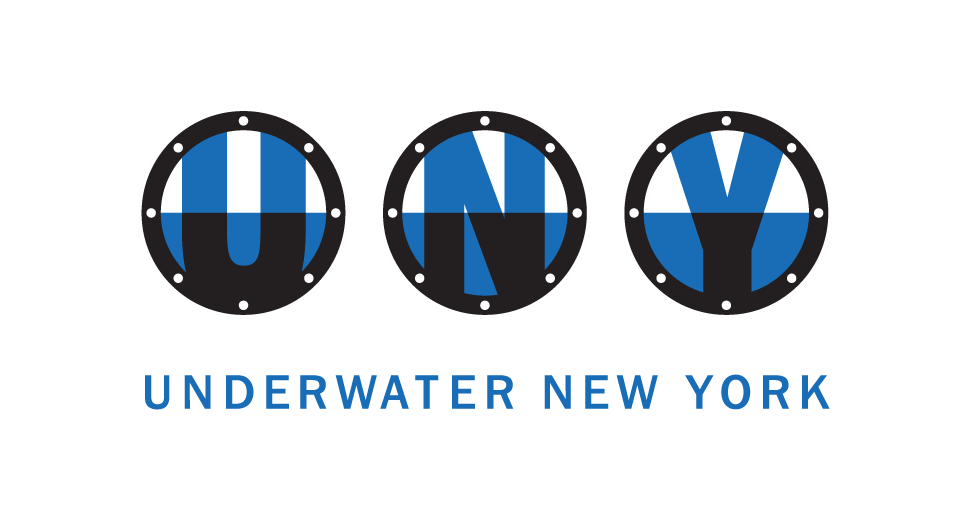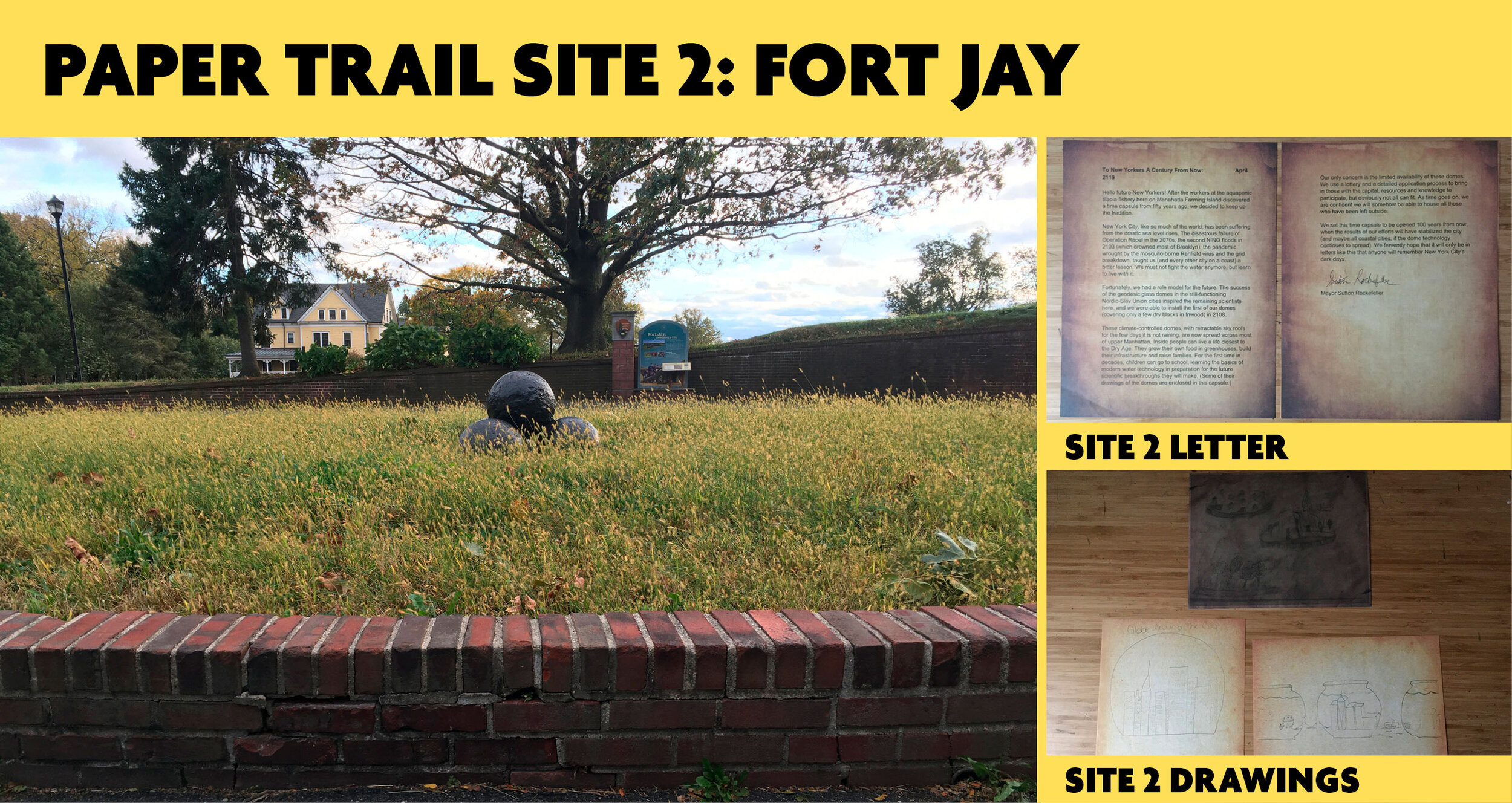Paper Trail
Paper Trail: A Tour of Governors Island’s Most Bizarre Buried Finds
We are the Governors Island Geocaching & Archaeological Society (GIGAS), a community of enthusiastic volunteers, not affiliated with any official organization, that loves to explore and uncover the secrets of Governors Island.
We made this tour to show you the weirdest, most bizarre finds we’ve dug up over the past few months. While we can’t reveal the original content, we can reprint some of what we found. We are hoping that if enough people see this, someone might help us solve the mystery.
Starting in May 2019, during some of our routine excavations around Governors Island, we found ourselves digging up several oddly shaped metal capsules. When we opened each of them, we found a letter written on some faded paper, along with what appears to be several children’s drawings and a few unidentifiable small objects.
For security reasons, and following a strongly worded request from the Governors Island management office, we are not able to show you anything more than a few blurry snapshots of the letters and drawings that we’ve found. They did allow us, however, to reprint the texts verbatim, which we’ve included below.
We truly can’t explain this. Can you?
--GIGAS
To New Yorkers of the future: March 15, 2069
Greetings from 2069! If you’ve followed the instructions in our time capsule, you are reading this fifty years later, in 2119. We’re excited to tell you about the historic moment that you no doubt know marked the beginning of the glorious age you live in now.
We are burying this capsule on the edge of the Manahatta Climate Research Complex (formerly Governors Island). As we stand here, we can see the still-majestic skyline of Manhattan across the dark mass of water. But the curving, waterlogged coastline is now covered with a series of giant steel machines soaring thirty feet into the sky, poised silently and waiting to be activated.
After nearly four decades of storms and floods, culminating in the disastrous NINO surges of 2049 (in which we lost Staten Island), not to mention all the chaos, displacement and disease, we are now fighting back with a massive wall of machines designed to suck up the water seeping—or pouring—into the city.
Operation Repel will be an old phrase by the time you read this, but for us it represents the result of a major collaboration the likes of which has never been seen. For nearly ten years, a group of carefully chosen scientists, engineers, architects and urban planners have been sequestered on this island, working together to design the solar-powered vacuums that will save our city.
Every New Yorker contributed to this effort: grade-school students submitted their own drawings (some of the best are in this capsule), financiers raised money and artists and writers helped us imagine this future. We are united by our fierce love of New York and our refusal to abandon it, unlike so many other coastal cities.
In just twenty-four hours, we turn the machines on. Our streets and stores and office buildings and apartments will be drained, and the clean-up will begin. We’ll no longer need gondolas, day-wetsuits, surgeboots, or extra-stiff hair frizz cream.
There are those of us that still remember the Dry Age, when we had sun and snow, and rarely worried about water. We can’t wait for the time when our children’s children—you who are reading this now—share some of the same memories.
Mayor Loisaida Stuyvesant
To New Yorkers a Century From Now: April 2119
Hello future New Yorkers! After the workers at the aquaponic tilapia fishery here on Manahatta Farming Island discovered a time capsule from fifty years ago, we decided to keep up the tradition.
New York City, like so much of the world, has been suffering from the drastic sea level rises. The disastrous failure of Operation Repel in the 2070s, the second NINO floods in 2103 (which drowned most of Brooklyn), the pandemic wrought by the mosquito-borne Renfield virus, and the grid breakdown taught us (and every other coastal city) a bitter lesson. We must not fight the water anymore, but learn to live with it.
Fortunately, we had a role model for the future. The success of the geodesic glass domes in the still-functioning Nordic-Slav Union cities inspired the remaining scientists here, and we were able to install the first of our domes (covering only a few dry blocks in Inwood) in 2108.
These climate-controlled domes, with retractable sky roofs for the few days it is not raining, are now spread across most of upper Manhattan. Inside, people can live a life closest to the Dry Age. They grow their own food in greenhouses, build their infrastructure, and raise families. For the first time in decades, children can go to school, learning the basics of modern water technology in preparation for the future scientific breakthroughs they will make. (Some of their drawings of the domes are enclosed in this capsule.)
Our only concern is the limited availability of these domes. We use a lottery and a detailed application process to bring in those with the capital, resources, and knowledge to participate, but obviously not all can fit. As time goes on, we are confident we will somehow be able to house all those who have been left outside.
We set this time capsule to be opened 100 years from now, when the results of our efforts will have stabilized the city (and maybe all coastal cities, if the dome technology continues to spread). We fervently hope that it will only be in letters like this that anyone will remember New York City’s dark days.
Mayor Sutton Rockefeller
Future City People! September Month, 2219
Hello future people! We found capsule on this island with all metal scrap heaps and glass piles. So we want to leave another letter here too.
We tell you our story so you have record of our time. 2219 is what calendar-keeper says is date.
New York City is two worlds. Inside and outside people. But not always peaceful. The riots of 2130 split us all in two. Shattered domes, who got let in. Then so many died from the fever in 2154. But we build it all back up again.
Me and other dome people stay in the dryness. But we have work to do. We run power grid with feet, we grow vegetables and fish, and we learn alphabet so we can sit together at night and look at paper-words we find in stone lion building under Bryant Lake. Right now we all read “A Tree Grows In Brooklyn.” Hah, we laugh. Nothing but reeds grow there now.
The outside people live in water most of the day. But they are okay. The Nordic-Slav people brought us gill and fin implants in 2178 and showed us how to make more on our own. So we stick that in all outside people when they are babies. Then they can always breathe underwater and swim for hours.
Now they are scavengers. They call themselves mermaids. All days swimming through our underwater city, rusted lobbies, storefronts, and even subway tunnels if they dare. At night they bring us what they find and we swap what we can use with food from dome. They all get to eat and then go to sleep on dry floors of last remaining skyrises.
So we all work together. Dome people and mermaids. Everybody follow rules to survive. That is New York City today.
Our best artists draw mermaid people for capsule. We are all safe now, so far. We stay alive and try to keep our paper-words dry. This is our story for you, future. What story will you tell?
Mayor Lenox Yorkville
To all New Yorkers: Hot, wet, rainy season of 2319
By our estimation of your calendar, it is 2319, and we’re standing on a small patch of waterlogged grass and stone in a vast murky sea.
When we look around, all we see is a few tiny islands poking up out of the water in one direction. In another, there’s a grid of rusted steel structures reaching up toward the sky. There’s even a giant woman, with a raised hand, covered in a greenish metal. It is rainy and windy and hot (around 100 degrees by your measurement). But nowhere is there a sign of life, except for the weeds.
We knew when our bioship landed that humans had once lived here. Our sensory devices shine beams deep underwater. There are buildings, ships, cars. We see this had been a glorious metropolis.
Now we dive and dig everywhere, looking for clues to your past. On this tiny scrap island, our research team found capsules with letters addressed to the future inside. But in 2219, they stopped. (Our interplanetary translation implant has never failed us yet. Now we can read and write your language as perfectly as you.)
What we’ve learned so far is that you are a species that likes to tell stories (is it a carbon-based trait?). And we’d like to tell you a story too. (We also made drawings to show you what it's like here now.)
You see, we lived on a planet like yours, but our chemicals and machines ruined it. Made it hard to breathe and grow food. So we had to leave. Now we are refugees, searching for a new home. (Don’t worry: your planet is just a stopping point. Too watery and too many of your volatile species left.)
From those letters, it looks like you may have the same story. But we might be able to help. We have the ability to bend the time-space continuum in atmospheres like yours. And it seems like 200 years ago was the last possible time you had to really alter the course of your future. So we are bringing the capsules from 2069, 2119, and 2219 back to where they were originally buried.
To the people of New York in 2019: we hope you find those letters soon. They’re both a gift and a warning. It’s not too late.
PXTVVVVVHHHHX
Planet LHS 1140b, Cetus
[It would be impossible to transliterate our signature and name, so this is an approximation in your human language.]
Paper Trail is a mixed-reality experimental climate change fiction project. Inspired by climate change research and sea level projections, the tour depicts New York City in different future eras as it grapples with rising sea levels—unless we do something more to combat climate change today.
Paper Trail was developed by A.E. Souzis during her WoW/UNY residency in 2019, and was inspired by (and features) drawings of possible NYC futures made by Governors Island visitors during her 2018 WoW/UNY residency with /rive collective. Graphic design courtesy of Lawrence Kim.
Body of Water
New York Harbor, Buttermilk Channel
About the Artist
A.E. Souzis is a New York City-based writer and interdisciplinary artist. Her writings, site-specific tours and installations use storytelling, technology and play to uncover or reimagine public space, alternative or underground histories and real-life networks of power. Her work has been featured in venues and publications including the Queens Museum, Transit Museum, Art in Odd Places festival, the website Urban Omnibus and journal Cultural Geographies, among others. She is also a member of /rive, an artist collective focusing on site-specific, locative projects that meet at the intersection of psychogeography, locative media and documentary narrative.





